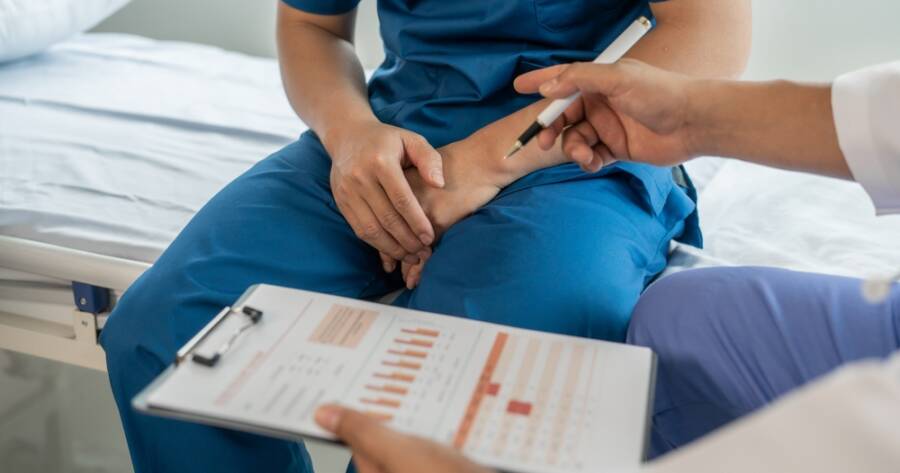We hear a lot about prostate cancer, but we can’t overlook testicular cancer. While it’s common, testicular cancer doesn’t get as much attention. Fortunately, you can learn everything you need to know about testicular cancer with a search online.
Early detection of testicular cancer significantly increases survival rates. That makes raising awareness crucial for saving lives. Bearing this in mind, let’s explore six key facts about testicular cancer.
1. Testicular Cancer: A Disease Affecting All Ages
The American Cancer Society states that although the majority of testicular cancer cases occur in males aged 20 to 34, it can affect males at any stage of life, including the elderly and infants.
Yolk Sac Carcinoma is the predominant type of testicular cancer in infants, characterized by tumor cells resembling a human embryo’s yolk sac. This form of testicular cancer in young children often responds positively to chemotherapy and is typically treatable.
2. Symptoms Can Manifest in Different Body Parts
The most common symptom of testicular cancer is a testicular lump, often about the size of a pea or larger. However, CancerResearchUK.org points out that testicular cancer can metastasize to other lymph nodes in the body.
Instances of detecting testicular cancer from lumps in the neck or other areas have been recorded. Nonetheless, it’s important to remember that a testicular lump doesn’t always indicate cancer. A UK clinic found that out of 2,000 men with a testicular lump, only 76 had testicular cancer. Non-invasive tests conducted by a doctor can confirm the diagnosis.
3. Known Risk Factors for Testicular Cancer
Per the American Cancer Society, several risk factors exist for testicular cancer beyond age. Cryptorchidism, where a testicle doesn’t descend, is one such factor, predominantly occurring in the affected testicle.
Other factors include genetic history (having a family member with the same cancer), HIV infections, and racial demographics, with white men in the U.S. being at higher risk. Additionally, taller individuals may face increased risk.
4. Variable Growth Rates in Testicular Cancer
Testicular cancer is categorized into two types: seminomas and nonseminomas. CancerResearchUK states that seminomas, making up around 45% of cases, grow slowly and usually affect men in their 30s and 40s. Nonseminomas, on the other hand, are more aggressive and prevalent.
Both types originate from germ cells in the testes responsible for sperm production. Nonseminomas, in particular, can spread rapidly.
5. Impact on Estrogen Levels in Men
While men naturally have both testosterone and estrogen, the presence of a testicular tumor can elevate estrogen levels. This increase can lead to gynecomastia, colloquially referred to as “man boobs.” However, the occurrence of gynecomastia does not necessarily indicate testicular cancer.
6. Life Post-Treatment Remains Functional
The Mayo Clinic emphasizes that testicular cancer usually impacts only one testicle, meaning the other can compensate for hormone production, essential for various bodily functions, including facial hair growth and maintaining libido. The loss of a testicle doesn’t equate to a loss of masculinity, as the remaining testicle can function effectively. For aesthetic concerns, the option of a synthetic testicle is available, as mentioned on the Planned Parenthood website.
Furthermore, advancements in medical treatments have greatly improved the quality of life for survivors, with many returning to their normal routines and activities soon after recovery. It’s also important to note that regular follow-up care is essential for monitoring health and detecting any potential recurrences early, ensuring ongoing well-being and peace of mind
Importance of Regular Check-Ups and Self-Examinations
Regular medical check-ups and self-examinations play a crucial role in the early detection of testicular cancer. Men are encouraged to perform self-examinations monthly to familiarize themselves with the normal feel and appearance of their testicles. This practice makes it easier to notice any changes or abnormalities, such as lumps, swelling, or pain.
Healthcare professionals also stress the importance of regular medical check-ups, especially for those with known risk factors. These visits can include physical examinations and, if necessary, additional tests like ultrasounds or blood tests to check for tumor markers. Early detection through these methods significantly increases the likelihood of successful treatment and recovery.
Awareness and Early Detection Are Key
Understanding testicular cancer is crucial for early detection and effective treatment. This article has highlighted various aspects of the disease, from its occurrence across all age groups to the specific symptoms and risk factors associated with it. The diverse manifestations of testicular cancer underscore the importance of regular self-examinations and seeking medical advice when abnormalities are detected.
While the thought of cancer is intimidating, the high treatability of testicular cancer, especially when caught early, offers hope. It’s also reassuring to know that life after treatment can continue normally, with minimal impact on one’s daily functions and quality of life. Staying informed and vigilant is the best defense against testicular cancer, enabling individuals to take prompt action for their health and well-being.
